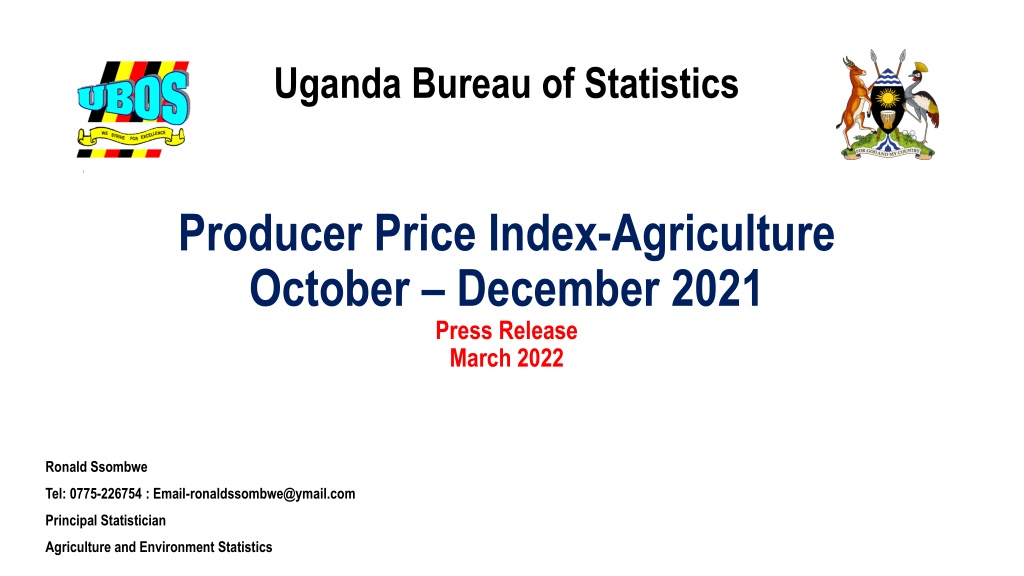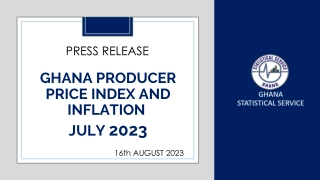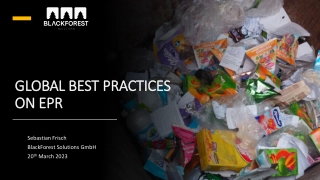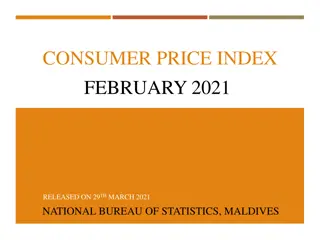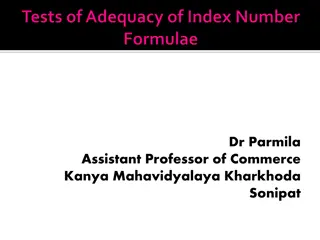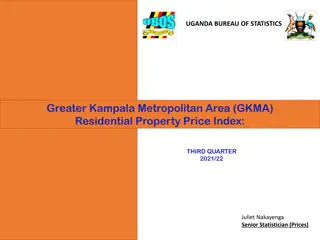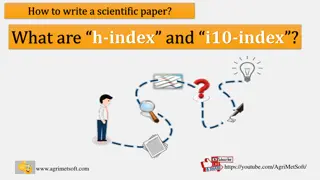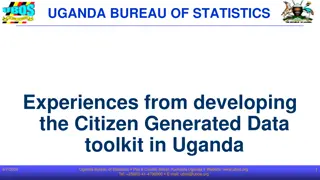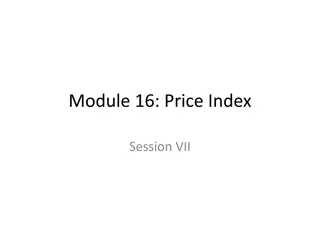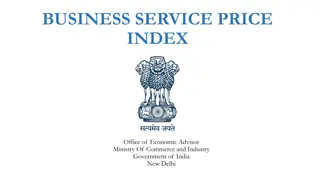Uganda Bureau of Statistics Producer Price Index - Agriculture Overview
The Uganda Bureau of Statistics (UBOS) produces and disseminates the Producer Price Index Agriculture to show the farm-gate prices received by farmers for primary agricultural products. The index is used by various stakeholders for policy-making and decision-making purposes. It covers key agricultural statistics and variables such as crops, fish production, animal production, and forestry. The purpose of the index is to monitor producer price inflation and track price patterns over time. The PPI-A covers a range of agricultural products under the International Standard Classification, contributing to the development and monitoring of agricultural trends in Uganda.
Download Presentation

Please find below an Image/Link to download the presentation.
The content on the website is provided AS IS for your information and personal use only. It may not be sold, licensed, or shared on other websites without obtaining consent from the author. Download presentation by click this link. If you encounter any issues during the download, it is possible that the publisher has removed the file from their server.
E N D
Presentation Transcript
Uganda Bureau of Statistics Producer Price Index-Agriculture October December 2021 Press Release March 2022 Ronald Ssombwe Tel: 0775-226754 : Email-ronaldssombwe@ymail.com Principal Statistician Agriculture and Environment Statistics
Uganda Bureau of Statistics Content Overview of the PPI-A PPI-A 2019-2021 PPI-A Oct-Dec 2021
Introduction Production of the PPI-A The Producer Price Index Agriculture is one of the indices produced and disseminated by the Uganda Bureau of Statistics (UBOS) under the UBOS Act No. 12, 1998. Users Main users of the index include; Ministry of Agriculture, Animal Industry and Fisheries, FAO, Ministry of Finance, Planning and Economic Development , Central Bank, Ministry of Trade, Media, the Higher Local Governments, Non-Government Organisations, Private sector involved with trade and agro-industrialization, Research & Academics, among others. UBOS Strategic goal. Increased use of statistics for development results.
Purpose of the Producer Price Index Produced to show the pattern and level of the average farm-gate farmers/producers for a unit of primary agriculture products over time with reference to a base period. price received by To measure producer price inflation which the average change in the selling price received by farmers over a period of one year. To monitor policy outcomes and decision-making for development.
Definition of Producer Price / Farm-gate price The average basic price received by farmers in the domestic market for a specific primary agricultural commodity available at the farm or at a selling point near their residences (e.g. Farmers market) ISIC & OECD The producer price /farm-gate price and does not include taxes, delivery and transport costs/charges. The producer prices are collected monthly by a team of market monitors based in the local areas.
PPI-A Variable Coverage 1. Crops Production - Food & Cash crops 2. Fish Production - Catch & Aquaculture 3. Animal production-Animal, birds, products 4. Forestry & Logging
PPI- Agricultural Basket International Standard Classification Group Growing of Cereals Growing of Leguminous crop Growing of oil seeds Growing rice Growing leafy or stem vegetables Examples 00 01 02 03 04 Maize, Millet, Sorghum Beans, Peas G. nuts, Soya, Sim-Sim, Palm-oil Super , Kaiso Cabbage, Gobe, Spinach, Sukuma, etc Tomatoes, Egg-plants, watermelon, Pumpkin, Bitter 05 06 07 08 09 10 11 12 13 14 19 20 21 22 23 24 25 26 27 28 Growing of fruit bearing vegetables Growing of bulb or tuberous vegetables Growing of roots tubers Growing sugarcane Growing tobacco Growing of fibre crops Growing of tropical fruits and subtropical fruits Banana and plantain Growing of citrus fruits Growing of beverage crops---Mainly Cash-crops Raising of Cattle Production of raw milk Raising of sheep and goats Raising of swine/pigs Raising of poultry Production of eggs Raising of other animals Bee keeping and production of honey and beeswax Forestry and Logging products Fresh and Aquaculture fisheries tomatoes, Cucumber Onions , Carrots Sweet Potatoes, Irish, Cassava, Yams Sugar-cane for making sugar Tobacco leaves Cotton Jackfruit, Pineapple, Avocado, passion Banana(food), Sweet bananas Oranges, Lemons, Tangerines Coffee, Tea, Cocoa, Vanilla Indigenous and Exotic Cows, Bulls, Heifer, Steers A basket of 95 Commodities produced in the domestic economy Unprocessed Milk Local and exotic Sheep, Goat, Ram Boar , Sow Hen, Cock, Ducks, Turkey, Local and Exotic eggs Rabbits Honey Firewood, kalitunsi, timber, fencing & Rafter pole Tilapia, Nile-Perch, Silver, Catfish
Data sources Details on sources 21 Crop Markets 23 Livestock Markets 21 sources for Cash-crop prices 10 sources for Fish & Aquaculture 15 Forestry product providers 44 Markets Data collection is conducted monthly by market monitors using paper questionnaires.
Data sources Location Central Eastern Northern Western Masaka Soroti Lira Rukungiri Rakai Bukedea Alebtong Isingiro Lyantonde Palissa Apac Sheema Lwengo Tororo Dokolo Kabale/Rubanda Nakaseke Iganga Agago Kiruhura/Kazo Kaberamaido Gulu Ntungamo Kumi Zombo & Nebbi
Methodology Base Period is 2016/17 Agricultural commodity Divisions(ISIC Rev 4) and Weights(SUT) Division Weight Crop Production 727.89 Animal Production 154.11 Fish & Aquaculture production 80.72 Forestry and Logging 37.27 Formula: modified Lasperyers Index approach-fixed weights in base period Price-per-kg is the standard data used for most of the basket items with quarterly revisions.
Trend of Farm-gate Prices 2020 -2021 A Mar-June 2020 decline Covid-19 reduced demand for items caused by limited access to the rural areas by buyers. Most prices reduced considerably as farmers competed for buyers. lockdown, of items Since June 2020, famer prices has had an upward trend to Dec 2021
PPI-A Inflation 2018-2021 It is normal that the Inflation is positive and negative due to the cob- web structure agricultural prices. 8.0 6.9 5.7 6.0 of 4.0 Percent 2.0 0.0 However, when a country experiences stress/bottlenecks agricultural production and supply , inflation outcome may reflect differently. -2.0 -2.5 in -4.0 -4.3 -6.0 2018 2019 2020 2021
PPI-A Inflation 2019 2021 by Division The overall change in average prices for the Agricultural increased by 5.7 % in 2021. basket In 2020, due to the Covid-19 farmers prices for the agricultural basket declined by 2.5% lock-down items
Annual Price Inflation Oct Dec 2021 by Division
PPI-A Annual Inflation Dec 2020 Dec 2021 by Division
Quarter-on- Quarter Changes in 2021 Q 3 & Q 4 Comparison between Q3 (July-Sept ) and Q4 ( Oct Dec) 2021. The commodities are determined by supply/demand pressures of during the festive season. prices for agriculture Overall there was high demand for crops and animals as expected. So crop prices increased by 3.3% while animal prices increased by 0.5%. However, between Q3 &Q4, the PPI-A declined by 0.2% mainly caused by reduced prices of fish.
Quarterly Changes in 2021 Q 3 & Q 4-Table 3 2021 Division/Group July-Sept Oct-Dec 4.0 14.1 -4.7 -2.1 -7.1 43.0 0.0 -5.7 2.6 -5.7 28.2 8.7 11.9 3.0 -36.8 4.9 0.5 3.3 16.3 -13.6 8.4 -9.7 -9.1 -9.8 26.1 2.6 0.0 59.6 188.3 12.8 17.8 -13.4 -5.7 -0.3 Crop Production 01 02 03 04 05 06 07 08 09 10 11 12 13 14 15 16 Growing of cereals (Except rice) Growing of Legumious crop Growing of oil seeds Growing rice Growing leafy or stem vegetables Growing of fruit bearing vegetables Growing of root, bulb or tuberous vegetables Growing of root tubers Growing sugarcane Growing tobacco Growing of fibre crops Growing of tropical fruits and subtropical fruits Banana and plantain Growing of citrus fruits Growing of beverage crops Growing of Spices, Aromatic crops/Vanilla
Quarterly Changes in 2021 Q 3 & Q 4-Table 3 2021 Division/Group July-Sept Oct-Dec 13.4 9.6 7.7 15.5 10.8 17.9 14.2 1.8 3.8 3.8 -14.2 -14.8 17.2 3.9 0.5 2.9 10.1 -3.9 1.9 5.9 0.2 19.9 -4.3 -4.3 -34.9 -35.4 -18.4 -0.2 Animal Production 1 Raising of cattle 2 Production of of raw milk 3 Raising of sheep and goats 4 Raising of swine/pigs 5 Raising of poultry 6 Production of eggs 7 Raising of other animals (Honey pdn & Rabbits) Forestry and Logging products 1 Logging Fresh and Aquaculture Fisheries 1 Fresh water Fisheries 2 Fresh water Aquaculture Fisheries PPI-A
Month-on-Month Inflation Oct - Dec 2021 by Division
Month-on-Month Inflation Oct - Dec 2021 by Division Table 2 Division/Group Oct-21 Nov-21 Dec-21 Crop and Animal Production 0.6 1.3 7.3 0.4 0.8 8.9 -3.4 -1.4 1.9 -9.9 2.1 -7.6 -0.6 0.0 -20.0 0.0 5.0 5.7 4.1 -2.7 -0.9 -2.4 -3.5 -0.2 -1.2 1.7 -1.4 2.7 1.4 1.9 1.9 -4.7 -5.8 29.1 0.2 1.7 1.6 0.4 -0.6 -3.9 6.0 -3.5 10.8 13.5 -2.2 0.0 7.4 2.6 -3.1 3.6 26.6 13.2 1.9 4.7 9.6 -5.9 5.1 2.5 -1.9 -1.0 -3.7 7.2 7.2 14.8 15.8 -8.2 2.5 Crop Production 01 02 03 04 05 06 07 08 09 10 11 12 13 14 15 Animal Production Growing of cereals Growing of Legumious crop Growing of oil seeds Growing rice Growing leafy or stem vegetables Growing of fruit bearing vegetables Growing of root or tuberous vegetables Growing of roots tubers Growing sugarcane Growing tobacco Growing of fibre crops Growing of tropical fruits and subtropical fruits Banana and plantain Growing of citrus fruits Growing of beverage crops -10.4 12.7 -9.8 2.6 -6.5 13.4 3.7 0.0 50.0 178.2 0.9 -4.6 -14.9 -8.2 -1.7 -3.9 -4.3 -3.1 -2.4 4.9 9.3 19.1 21.1 -9.5 -9.5 -30.3 -30.1 -35.3 -2.0 16 17 18 19 20 21 22 23 Forestry and Logging products Raising of Cattle Production of raw milk Raising of sheep and goats Raising of swine/pigs Raising of poultry Production of eggs Raising of other animals (honey & rabbits) Bee keeping and production of honey and beeswax 24 Fresh and Aquaculture fisheries Logging 25 26 PPI-A Fresh water Fishing Fresh water Aquaculture
Crop, Animal, Fish Prices in 2021 Q4 Turning points for farm-gate prices Mar-June 2020 decline low demand for animals and crop due to covid-19 lock down Cereals; Maize, Millet, Sorghum increased by 16.3% Oil seeds; G.nuts, Sunflower, Sim-sim increased by 8.4% Jan-March 2021 rise in crop prices was due to scarcity and planting season. Root-Tubers; Potatoes, cassava increased by 2.6% Jan-March 2021 decline in animal prices was due reduced demand after the December festive season. Controls requirements, local & International demand are pushing up fish prices. on fishing, cost of
Background Agriculture is a source of livelihood to majority of Households in Uganda and an effective mechanism for growth of other sectors(NDP) About 80% of households are engaged in agriculture-Census 2014. About 47% of Households in urban and 92% in the rural are engaged Agriculture- Census 56% of Households are in pure subsistence farming(unhs) 64.3%(2016/17) to 68.1%(2019/20) of the working population are working in Agriculture (UNHS) 39%(2016/17) to 47%(2019/20) of the working population are in subsistence Agriculture (UNHS) Accounts for 36% of employment(paid work) in Uganda. Households with enterprises based in Agriculture increased 6.5% (2016/17) to 7.5% (2019/20) Due to covid-19, working persons in subsistence Agriculture increased 41% - 52% (UNHS) Agriculture sector contributed 24.0% to overall GDP at current prices in 2019/20 The sector recorded a growth rate of 4.8% in 2019/20 Commercialization of Agriculture continues to linked farms to the market economy.
